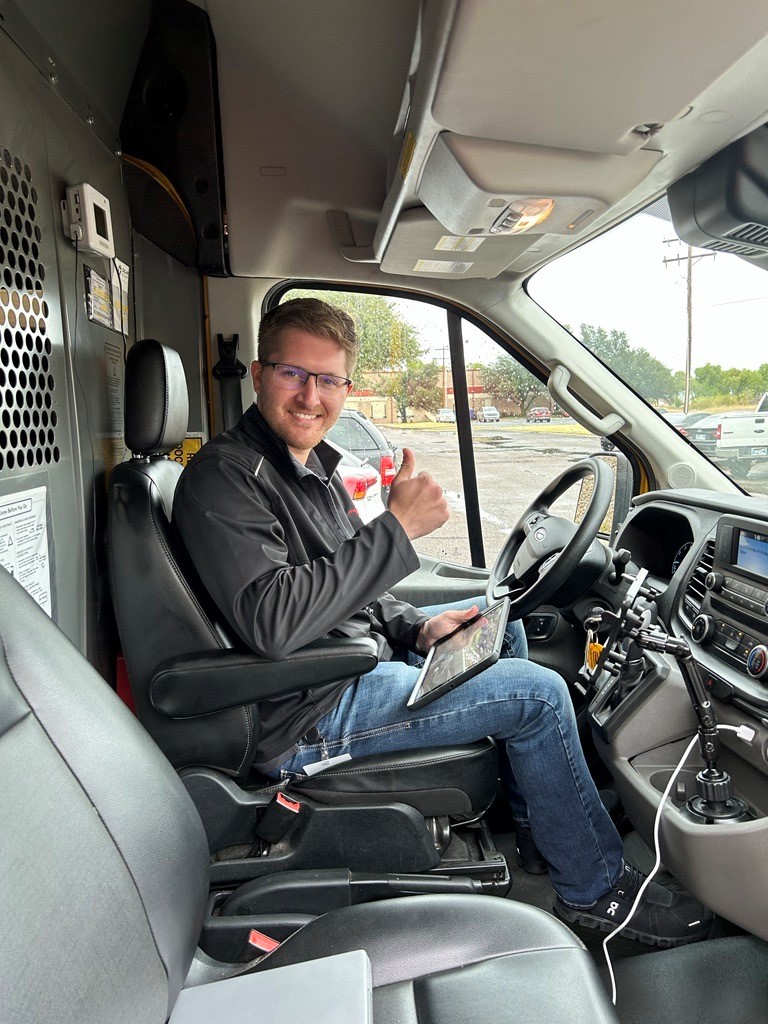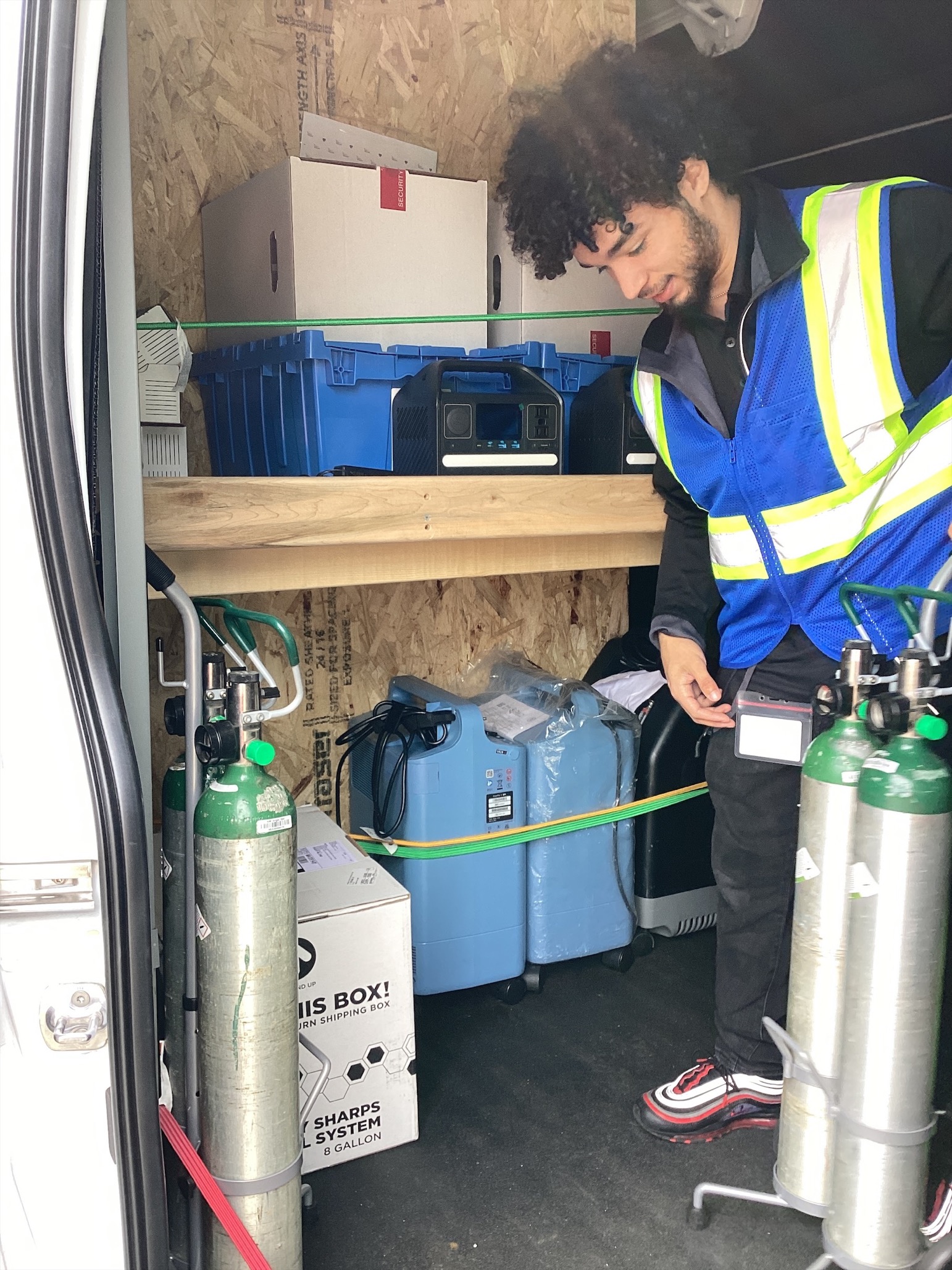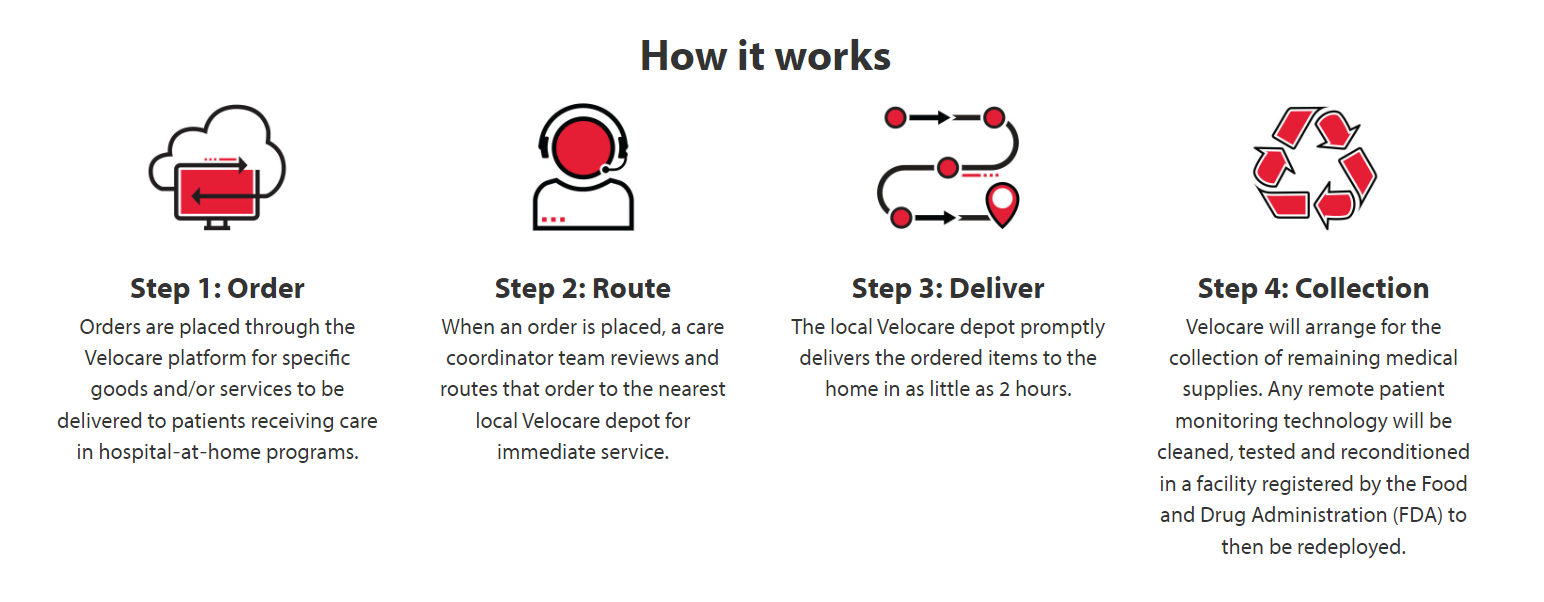Cardinal Health MarketSM
The legacy Cardinal.com Medical Ordering site has been replaced with Cardinal Health MarketSM, a new product experience designed with you in mind.
Cardinal Health at-Home Solutions plays an instrumental role in providing patients and caregivers critical tools they need for care in the home. This article is part of an ongoing series on the innovations, products and services the business delivers directly to patients’ doorsteps on behalf of its 5 million customers nationwide.
 In November 2022, Cardinal Health at-Home Solutions went all in on the hospital-at-home movement. With an investment in Medically Home, it launched Velocare as a pilot and began delivering medical supplies, equipment, products and technology services to patients who were admitted into hospital-at-home programs across the U.S.
In November 2022, Cardinal Health at-Home Solutions went all in on the hospital-at-home movement. With an investment in Medically Home, it launched Velocare as a pilot and began delivering medical supplies, equipment, products and technology services to patients who were admitted into hospital-at-home programs across the U.S.
Cardinal Health at-Home Solutions is a leading medical supplies and products distributor. As a division of at-Home Solutions, Velocare is uniquely positioned to support hospitals by delivering and maintaining supplies and installing the technology needed for a hospital-at-home program. The Velocare platform developed by Cardinal Health to deliver this solution allows for rapid response to new patients being admitted into a health system’s hospital-at-home program. Because of its connection to at-Home Solutions, Velocare can offer a wide range of medical supplies and solutions utilizing the business’ nearly 50,000 available product offerings and Cardinal Health’s robust distribution center network, which offers space for Velocare’s warehouse depots. This ensures medical supplies, durable medical equipment, nutritional support, medical gases, general courier services and more get to the patient in as little as two hours.
In March 2023, Velocare rolled out of its pilot, expanding to its second health system customer. Just one year later, it’s serving more than a dozen health systems and hospitals across the country as the distribution leg of their hospital-at-home programs.
In total, Velocare has made nearly 10,000 deliveries to patients’ homes across the country – serving thousands of patients nationwide. And, Velocare is growing steadily, already working with leading hospitals in major metropolitan areas across the U.S., including Portland, Oregon; Boston, Detroit, Atlanta and more. Next month, it will launch in its largest metro area yet: Los Angeles.
Alex Hoopes, the senior director of strategy and execution for Velocare, was instrumental in innovating and developing Velocare and continues to lead this business today. He said, “Since COVID-19, the U.S. healthcare system has been working through clinical workforce shortages, overflowing hospitals and increasing costs. Couple that with an aging population and an overall patient desire to recover in the home, you have the perfect recipe for accelerating the spread of hospital-at-home programs across the country.”
Why hospital-at-home is sweeping the nation
According to results from the Hospital-Level Care at Home for Acutely Ill Adults: A Randomized Controlled Trial (published in the Annals of Internal Medicine), the adjusted mean cost of an acute hospital-at-home care episode was 38% lower when compared to an inpatient episode in the traditional hospital setting. The report states this is likely because hospital-at-home patients require fewer lab orders and imaging studies. The study also reported that hospital-at-home patients are readmitted to the hospital within 30 days only 7% of the time, versus 23% for those who recovered in the hospital setting.
In addition, hospitals continue to struggle with a lack of space to accommodate a growing number of patients. In 2022, the United States had 2.35 hospital beds per 1,000 people, according to the KFF (formerly, the Kaiser Family Foundation). The KFF also reports that there were 95 hospitalizations per 1,000 people in the U.S. in 2022, underscoring the shortage our healthcare system faces.
 “During the pandemic, we began to hear stories of patients being treated in hallways because of bed shortages. While we’re not where we were during the pandemic, we’re still seeing a strain on bed capacity and available staff to treat the number of patients being admitted to our hospitals annually,” Hoopes said.
“During the pandemic, we began to hear stories of patients being treated in hallways because of bed shortages. While we’re not where we were during the pandemic, we’re still seeing a strain on bed capacity and available staff to treat the number of patients being admitted to our hospitals annually,” Hoopes said.
Hoopes says that hospitals that are at capacity are likely to find that it’s a lot more cost effective to offer a hospital-at-home program versus having to add an entire new wing or building. He said, “Not only that, but solutions like Velocare help remove some of the administrative burden of hospital-level patient care that oftentimes is a clinician’s responsibility.”
Eligible patients can receive hospital-level care in the home for several acute illnesses – pneumonia, diabetes complications, cellulitis or heart failure, to name a few. Eligibility varies by health system, but common criteria may include stable vital signs and a geographic proximity to the hospital. To participate in the program, the patient must have running water and electricity, but, Hoopes said, they don’t even need to have Wi-fi in their home.
At the core of hospital-at-home programs are three essential pillars: A command center, in-home clinicians, and supplies and services. The digital command center orchestrates meticulous care planning and coordination, while the in-home clinicians deliver personalized care directly to the patients. (Patients connect digitally with their care team – and in-home clinicians or first responders come into the patient’s home to do daily vital checks and help administer medications. First responders are often utilized for these programs because many patient needs are simple enough to not require a trip back to the hospital, such as a blood-pressure check or a dip in blood pressure, according to this report.)
Velocare serves as the third pillar focused on supplies and services, aiming to streamline the complexities of scaling and managing a health system’s hospital-at-home program by providing end-to-end logistics and inventory management.
Hoopes said, “Supporting these vital functions is the backbone of Velocare. Because we’re a division of Cardinal Health at-Home Solutions, we’re uniquely positioned to physically bring high-acuity care directly into the home. We distribute and deliver the supplies and services needed to make these programs possible.”
Manufacturing the magic of Velocare

When a patient goes to the emergency room (ER) at a participating health system, they may be given the option to be admitted and transferred to a floor within the hospital – or transferred back to their home. That’s when Velocare comes in – when a hospital determines a patient will be transferred to their own home for the remainder of their hospital stay, a Velocare technician is dispatched.
Velocare technicians operate “warehouses on wheels” that are fully equipped and stocked with items you’d see in a typical hospital room, including monitoring technology, oxygen systems, IV equipment, and even medically approved meals. And they deliver it as quickly as possible directly to the patient’s home. In fact, more than half of Velocare’s deliveries are made in under 75 minutes.
“This is when the magic happens – the clinicians caring for the patient often tell us how their patient’s eyes light up when they see the hospital room completely set up for the first time in their home,” Hoopes said. “That feeling that we helped someone find comfort during their recovery is one of the best parts of working for our business.”
 Wilson Diaz is a Velocare technician based in the Treasure Coast of Florida, where he serves one of the major hospital systems there. Diaz says the home technology kit Velocare technicians install allows the patient to communicate with their doctors and nurses, transmit vitals back to their medical team and reach out for support when they need it.
Wilson Diaz is a Velocare technician based in the Treasure Coast of Florida, where he serves one of the major hospital systems there. Diaz says the home technology kit Velocare technicians install allows the patient to communicate with their doctors and nurses, transmit vitals back to their medical team and reach out for support when they need it.
“Patients can recover surrounded by their family – and pets – but they still receive the same level of care and personal attention they would within the four walls of a traditional hospital,” Diaz said.
Velocare technicians visit the home throughout a patient’s “hospital stay” to check on technology, deliver new products, meals or supplies based on their needs, and help to ensure appropriate disposal of medical waste. (Patients being treated via the health systems that Velocare works with tend to have an average hospital-at-home stay of roughly three to five days.) When the patient is ready to be discharged, they return to the home to remove all equipment and waste.
Leo Baribeau is the Velocare supervisor in Boston where Velocare serves two major hospital systems. He says the positive impact this program has on patient recovery is something he values deeply.
“I had a patient in the program who told us, ‘I feel so much better being home rather than in the hospital – I can sit on my porch in the sun and know that I’m still getting care,’” Baribeau said.
Diaz added, “My proudest moment working for Velocare was the day that a patient’s daughter expressed her gratitude and appreciation that her father was still alive and doing well because of his participation in this program. I am proud to be part of the Velocare team. I am proud to work for Cardinal Health, and I am proud of being able to help have a positive impact on patients’ lives.”
Advocating for hospital-at-home longevity
Hospital-at-home programs today are mainly operating under the Centers for Medicare & Medicaid Services (CMS) Acute Hospital Care At Home Program. This was launched in response to challenges hospitals were facing because of the spread of COVID-19 in the early days of the pandemic.
Cardinal Health at-Home Solutions is advocating for the renewal of this CMS waiver program, which is set to expire in December 2024, to ensure the longevity of hospital-at-home programs across the country. Rob Schlissberg, president of Cardinal Health at-Home Solutions, said it is deeply important to patient care that CMS continues to support the mission of hospital-at-home.
“We will continue to advocate for the best interests of our customers and their patients – and the facts don’t lie,” he said. Hospital-at-home programs are simply good for patient outcomes, for lowering costs and for the entire healthcare ecosystem. We’re strongly committed to ensuring they continue to be an available option for patients in our country.”
To learn more about Velocare, click here.
Photos: Top: In 2022, Velocare made its inaugural delivery - the first time Cardinal Health at-Home Solutions had ever crossed the threshold into a patients' home. Second from top: Velocare technicians, like Laron Van Alstyne pictured here, deliver the supplies and install technology needed for health systems to run their hospital-at-home programs. Bottom: Wilson Diaz is a Velocare technician serving a Treasure Coast of Florida health system.